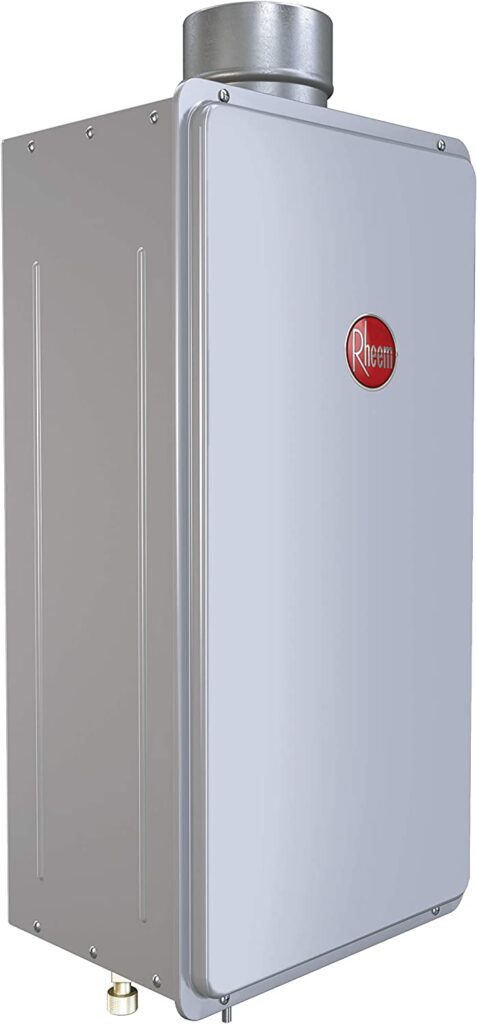Why Is Tankless Water Heater Installation So Expensive?
Tankless water heater installation can be quite expensive, and there are several reasons for this. The main reason is that tankless water heaters are far more energy-efficient than traditional tank-style water heaters. They only heat the water when it is needed, which means that they use much less energy and save money in the long run. However, the initial installation costs can be prohibitively high.
One of the primary factors that affect the cost of installing a tankless water heater is the fuel type. Gas tankless water heaters tend to be more expensive to install than electric models. This is because gas lines often need to be installed or adjusted, and this can be a significant expense. However, once the gas line is in place, gas tankless water heaters are typically more energy-efficient and can save more money in the long run.
Electric tankless water heaters are generally less expensive to install than gas models. However, they may not be as energy-efficient and may not be able to provide as many gallons of water per minute as gas models. This means that they may run out of hot water more quickly, which can be a problem for larger households or those with higher hot water usage.
Another factor that can affect the cost of tankless water heater installation is the type of unit being installed. There are two main types of tankless water heaters: point-of-use and whole-house. Point-of-use units are smaller and are designed to provide hot water to specific areas of the home, such as a bathroom or kitchen sink. Whole-house units are larger and provide hot water to the entire house.
Whole-house units tend to be more expensive to install than point-of-use units, as they require more powerful heat exchangers and may require additional work to install correctly. However, whole-house units are typically more energy-efficient and can save more money in the long run.
Natural gas tankless water heaters are generally considered to be the most energy-efficient and cost-effective option. They provide more gallons of water per minute than electric models, and they can save a significant amount of money on energy bills over time. However, as mentioned earlier, installing a gas line can be quite expensive, which may deter some homeowners from choosing this option.
Overall, the cost of tankless water heater installation can vary widely depending on a number of factors, including the type of unit being installed, the fuel type, and the complexity of installation. However, despite the upfront costs, tankless water heaters can be an excellent investment for homeowners who are looking to save money in the long run and reduce their environmental impact. By choosing an energy-efficient and high-quality unit, homeowners can enjoy reliable hot water and significant savings on their energy bills.
Frequently Asked Questions
What is a tankless water heater?
A tankless water heater, also known as an on-demand water heater, is a type of water heating system that heats water only when it is needed. Unlike traditional water heaters that store and heat a large amount of water in a tank, tankless water heaters heat water on demand as it flows through the unit. This provides hot water instantly and more efficiently, as it eliminates the standby heat loss that occurs in traditional water heaters. Tankless water heaters can be powered by gas or electricity and are available in various sizes to meet the needs of different households.
How does a tankless water heater work?
A tankless water heater, also known as an on-demand water heater, heats water directly as it flows through the unit without the use of a storage tank. When hot water is needed, cold water flows into the unit and is heated by a gas burner or electric element. The hot water then flows out of the unit and to the faucet or shower.
The heating process is controlled by a flow sensor that detects when water is flowing through the unit. The sensor signals the heating element to turn on, and the water is heated to the desired temperature. Once the water flow stops, the heating element turns off, conserving energy.
Because tankless water heaters do not store hot water, they can be more energy-efficient than traditional storage tank water heaters. They also provide a continuous supply of hot water, which can be beneficial for households with high hot water demand.
How much is a tankless water heater?
The cost of a tankless water heater can vary depending on the brand, model, and installation requirements. On average, a basic tankless water heater can cost anywhere from $500 to $1,500, while a high-end model can cost up to $3,000 or more. Installation costs can also add an additional $1,000 to $3,000 to the total cost.
How to install a tankless water heater?
1. Turn off the water supply and power source: Before starting the installation process, turn off the water supply and power source to the existing water heater.
2. Remove the old water heater: Drain the old water heater and disconnect the water and gas or electric lines. Remove the old water heater from its location.
3. Choose a location for the tankless water heater: Choose a location for the new tankless water heater that is easily accessible and has proper ventilation.
4. Install the new water heater: Install the new tankless water heater according to the manufacturer’s instructions. This typically involves mounting the unit on the wall and connecting the water and gas or electric lines.
5. Vent the tankless water heater: Vent the tankless water heater to the outside of the house. This may involve installing a new vent pipe or using the existing vent pipe.
6. Connect the water supply: Connect the water supply to the tankless water heater. This may involve installing new pipes or using the existing pipes.
7. Turn on the water supply and power source: Turn on the water supply and power source to the new tankless water heater. Check for leaks and test the unit to make sure it is working properly.
8. Dispose of the old water heater: Dispose of the old water heater according to local regulations.
What size tankless water heater do I need?
The size of the tankless water heater you need depends on several factors, such as the size of your home, the number of bathrooms and appliances that require hot water, and your hot water usage patterns. It’s best to consult with a professional plumber or a qualified tankless water heater installer to determine the appropriate size for your specific needs.
How to flush the tankless water heater?
1. Turn off the power supply: Before you start flushing the tankless water heater, turn off the power supply. If you have an electric water heater, turn off the circuit breaker. If you have a gas water heater, turn off the gas supply.
2. Shut off the water supply: Locate the water supply valve and shut it off. This valve is usually located near the water heater.
3. Drain the water heater: Locate the drain valve at the bottom of the water heater and connect a hose to it. Run the other end of the hose to a drain or outside. Open the valve and let the water drain out.
4. Flush the water heater: Once the water has drained out, close the drain valve and open the cold water supply valve. Let the water run through the heater for about 15 minutes to flush out any sediment or debris.
5. Turn off the cold water supply: After 15 minutes, turn off the cold water supply and let the remaining water drain out.
6. Close the drain valve: Once all the water has drained out, close the drain valve.
7. Turn on the water supply: Turn on the cold water supply and let the tankless water heater fill up.
8. Turn on the power supply: Once the tankless water heater is full, turn on the power supply. If you have an electric water heater, turn on the circuit breaker. If you have a gas water heater, turn on the gas supply.
9. Test the water heater: Once the tankless water heater is back on, test it to make sure it’s working properly.
What size tankless water heater?
The size of the tankless water heater you need depends on several factors, such as the size of your home, the number of bathrooms and appliances that require hot water, and your hot water usage patterns. It’s best to consult with a professional plumber or a qualified tankless water heater installer to determine the appropriate size for your specific needs.
What is the downside of a tankless water heater?
Here are some potential downsides of a tankless water heater:
1. Higher upfront cost: Tankless water heaters tend to be more expensive to purchase and install than traditional tank-style water heaters.
2. Limited hot water output: While tankless water heaters can provide an endless supply of hot water, they may not be able to keep up with high demand for hot water in larger households or during peak usage times.
3. Higher energy requirements: Tankless water heaters require a significant amount of energy to heat water quickly and efficiently, which can lead to higher energy bills.
4. Maintenance requirements: Tankless water heaters require regular maintenance to prevent mineral buildup and ensure optimal performance.
5. Potential for cold water “sandwich”: A “cold water sandwich” can occur when a tankless water heater shuts off briefly, leading to a brief period of cold water before the hot water resumes.
How long does a tankless water heater last?
A tankless water heater typically lasts between 15 and 20 years with proper maintenance and care. However, some models can last up to 25 years or more. The lifespan of a tankless water heater can also depend on factors such as usage, water quality, and installation quality.
How to clean a tankless water heater?
1. Turn off the power supply to the water heater. This may involve turning off the gas supply or unplugging the unit from the wall.
2. Close the water supply valve to the heater. This valve should be located near the unit.
3. Connect a garden hose to the drain valve on the bottom of the heater. Run the other end of the hose to a drain or outside.
4. Open the drain valve and let the water flow out of the heater. This may take a few minutes.
5. Once the water has drained out, close the drain valve and remove the hose.
6. Open the water supply valve to the heater and let the water fill the tank.
7. Turn the power supply back on to the heater.
8. Check for any leaks or other issues with the heater. If everything looks good, you’re done!
What is the average cost to put in a tankless water heater?
The average cost to install a tankless water heater ranges from $1,500 to $3,500, depending on the size and complexity of the installation. This includes the cost of the unit, installation, and any necessary upgrades to your home’s electrical or gas systems. However, the cost can vary depending on your location, the brand and model of the unit, and the specific needs of your home. It is recommended to get multiple quotes from licensed and experienced professionals before making a decision.
Is it worth it to install a tankless water heater?
Here are some pros and cons of tankless water heaters that can help you make an informed decision:
Pros:
1. Energy-efficient: Tankless water heaters are more energy-efficient than traditional tank water heaters. They only heat water when it is needed, which can save you money on your energy bills.
2. Space-saving: Tankless water heaters are smaller and take up less space than traditional tank water heaters, which can be ideal for smaller homes or apartments.
3. Longer lifespan: Tankless water heaters can last up to 20 years, which is longer than traditional tank water heaters.
Cons:
1. Higher upfront cost: Tankless water heaters can be more expensive to purchase and install than traditional tank water heaters.
2. Limited hot water supply: Tankless water heaters may not be able to provide enough hot water for larger households or homes with high hot water demand.
3. Maintenance requirements: Tankless water heaters require regular maintenance to prevent mineral buildup and ensure optimal performance.
Ultimately, whether a tankless water heater is worth it depends on your specific needs and circumstances.
Is more difficult to install a tankless water heater?
Generally, installing a tankless water heater can be more difficult than installing a traditional tank-style water heater. This is because tankless water heaters require a larger gas line and special venting to ensure proper operation. Additionally, electrical wiring may need to be upgraded to accommodate the higher voltage required by tankless water heaters. It is recommended to hire a professional plumber or HVAC technician to install a tankless water heater to ensure that it is installed correctly and safely.
How much value does a tankless water heater add to your home?
Tankless water heaters are considered a desirable feature by many homebuyers and can increase the value of a home. According to a study by the National Association of Home Builders, installing a tankless water heater can increase a home’s value by up to 4%. Additionally, tankless water heaters are energy-efficient and can save homeowners money on their utility bills, which can also be a selling point for potential buyers.
Do tankless water heaters increase electric bills?
Yes, tankless water heaters can increase your electric bill compared to traditional tank water heaters. This is because tankless water heaters use electricity to heat water on demand, which can require more energy than heating a tank of water and keeping it hot. However, tankless water heaters are generally more energy efficient and can save you money in the long run by reducing energy waste and lowering your overall energy consumption.













